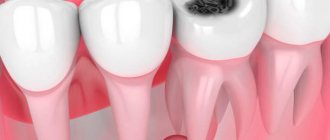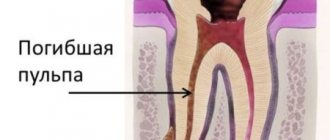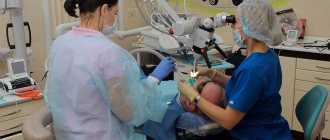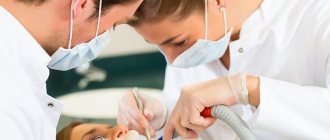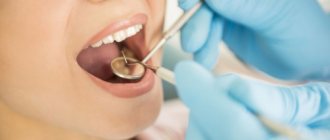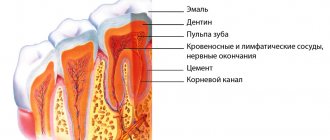October 22, 2017
Toothache is a symptom of many diseases. Many patients are in no hurry to go to the doctor because they believe that they can limit themselves to taking painkillers. However, pain is a “bell” from our body, so it tells us about problems. And toothache, especially acute pain, indicates the presence of acute inflammation in the tooth or the tissues around it. As a rule, we are talking about pulpitis and periodontitis - diseases that, without proper treatment, can lead to tooth loss.
Toothache
Many patients are interested in the difference between “pulpitis and periodontitis,” especially since there are often cases when, under the guise of one disease, doctors treat another. UltraSmile . ru offers to figure out how the patient can avoid getting confused in complex terminology and independently diagnose the problem.
Despite the fact that the diseases are different, to get rid of them requires complex endodontic treatment of the tooth canals. In modern clinics, it is carried out using a microscope, which allows you to efficiently clean the canals from inflamed tissues and preserve healthy structures to the maximum.
What is pulpitis?
Almost everyone knows that there is a nerve inside the tooth. But not everyone knows that it is called pulp. Pulpitis is an inflammation of the same nerve, or rather the neurovascular bundle, which is located at the root of the tooth. As a rule, pulpitis appears due to untreated caries, when bacteria that provoke the destruction of hard tooth tissues reach the internal nerve. In addition, the cause of the disease may be mistakes made by the dentist during the treatment of caries. This includes overheating of tissues when drilling with a drill, incorrectly selected and installed filling material, and incomplete removal of inflamed tissues.
Pulpitis
Development of pulpitis
Diagnostics
During the consultation, the dentist collects an anamnesis, comprehensively studies the patient’s complaints, examines for the presence of a destroyed organ, purulent discharge and fistula, and analyzes X-ray and electroodontodiagnostic data. Priority is given to x-ray examination, which makes it possible to differentiate the diagnosis of pathologies of the periapical system:
- visual/instrumental examination: percussion (tapping in all directions), palpation, bite assessment;
- root canal probing;
- radiation imaging;
- radiography, orthopantomography;
- determination of the oral hygiene index.
What is periodontitis?
Periodontal tissue is the tissue that surrounds the tooth and holds it in the jaw bone. Periodontitis is an inflammation of these ligaments, which causes tooth mobility. The disease is a consequence of advanced caries, untreated pulpitis and, unfortunately, in most situations leads to tooth loss.
Periodontitis
Dental disease: development of periodontitis
How gum and dental diseases manifest themselves
Regardless of the nature and complexity, dental diseases must be treated. People who visit the dentist at least twice a year protect themselves from the development of dental pathologies and dental diseases with regular visits to the doctor. Timely consultation with a doctor allows not only to carry out gentle treatment and prevent the development of the disease, but also to completely eliminate the consequences of the disease. Failure to see a doctor in a timely manner can lead to the development of complications, the appearance of concomitant diseases, damage to healthy teeth, tooth loss and disruption of chewing functions.
The following symptoms are reasons to consult a doctor:
- change in tooth color;
- The appearance of painful and uncomfortable sensations in the tooth or surrounding tissues;
- Sharp reaction of teeth to cold and hot foods;
- Mechanical damage to the tooth;
- Bad breath;
- Presence of tartar and abundant plaque.
Five main differences between periodontitis and pulpitis
The main cause of pulpitis and periodontitis is the same - caries, and the common symptom is quite severe pain. However, a good dentist will immediately determine what he has to fight with - pulpitis or periodontitis. The following characteristics allow you to distinguish one from the other.
Localization of inflammation
With pulpitis, the inflammatory process is localized clearly inside the tooth, and the tissue around it remains healthy. With periodontitis, first of all, inflammation occurs in the ligaments that hold the tooth in the socket, that is, surrounding the root. Moreover, if the inflammation has spread to the periodontium, this means that the nerve is no longer viable. Thus, periodontitis is a complication of pulpitis.
Nature of pain
With pulpitis, the pain is sharp, shooting, encircling and spreading throughout the jaw. With periodontitis, pain is also present, but it is not as severe, since the dental nerve, as a rule, is already dead and does not react to inflammatory processes. And in the tissues around the tooth there are no longer so many nerve endings - there is simply nothing to react so strongly to. With periodontitis, the pain is more monotonous, constant, and intensifies when pressing on the tooth, closing the jaws, or eating food.
Acute pain
Symptoms other than pain
With pulpitis, most often only acute pain occurs, and a black spot can be found on the tooth - this is caries that has spread deep inside the tooth. Other symptoms may be absent altogether. However, the presence of a carious cavity is also characteristic of periodontitis, since caries is the root cause of both diseases. In this case, with periodontitis, redness of the mucous membrane is observed, the formation of gum pockets with a large amount of plaque, tissue swelling (lips, cheeks) often appears, and body temperature rises, which does not happen with pulpitis.
Inflammation in periodontal pockets
Formation of pus
Very often, both with pulpitis and periodontitis, pus forms. But its location is again different, as are the exit routes. With pulpitis, pus comes out of the internal cavity of the tooth through the apex - that is, through carious lesions. With periodontitis, a small white “pimple” forms on the gum, which is precisely an indicator of the formation of pus in the internal tissues surrounding the tooth.
Flux: initial stage
Tooth mobility
With pulpitis, tooth mobility is impossible; with periodontitis, especially at an advanced stage of the disease, the tooth begins to loosen as the ligaments that hold it in the socket are destroyed. Periodontitis is the main cause of early tooth loss.
To diagnose both pulpitis and periodontitis, modern X-ray machines are used, which allow us to examine the tooth from the inside, as well as the tissue around it. In addition, x-rays are very important after treatment - to assess the quality of its implementation.
X-ray machine
The conclusion from all that has been said is obvious - it is best to treat caries, it is simpler, cheaper and not so painful. Visit the dentist 1-2 times a year and you may be lucky enough to never encounter diseases such as pulpitis and periodontitis.
Notice
: Undefined variable: post_id in
/home/c/ch75405/public_html/wp-content/themes/UltraSmile/single-item.php
on line
45 Notice
: Undefined variable: full in
/home/c/ch75405/public_html/wp-content /themes/UltraSmile/single-item.php
on line
46
Rate this article:
( 1 ratings, average: 5.00 out of 5)
toothache
Therapeutic methods for treating periodontitis
The key to successful therapeutic treatment is complete patency of the root canal. In this case, the root canal can be reliably sealed, which will eliminate it as a source of irritants that support the inflammatory process. Single-rooted teeth with canals that are easily accessible for treatment are treated therapeutically with medications, followed by filling the canals.
Treatment of acute process
Acute periodontitis is characterized by the following symptoms:
- Constant severe aching pain in the tooth;
- Increased pain in the tooth when biting or touching the tooth;
- Feeling of a grown tooth: the patient feels as if the tooth has moved out of the dental arch;
- The tooth becomes slightly mobile;
- Swelling of the gums develops;
- There is a headache, a feeling of malaise;
- Body temperature may rise to 38°C.
Death and decomposition of the pulp occurs in the root canals; the products of its decay, together with pathogenic microorganisms, penetrate through the apical foramen into the periodontium, causing its inflammation and destruction. Periodontitis can develop near a pulpless tooth due to improper root canal filling. In any case, the goals of treating periodontitis are the following:
- Cleansing root canals from pulp decay products.
- Destruction of pathogenic microflora.
- Elimination of the inflammatory process in the periodontium.
- Stimulation of periodontal regeneration processes.
- Preservation of the tooth.
Treatment of acute periodontitis is carried out in several visits; at the first visit to the dentist, the following actions are performed:
- At the initial consultation: examination, necessary photographs and studies, drawing up and agreeing on a treatment plan;
- Anesthesia;
- Preparation and treatment of carious cavities, creating access to root canals.
- Removal of the affected pulp and its decay products. If depulpation has already been performed previously, the canals are unsealed to provide access to the root apex.
- Instrumental channel processing. Using instruments, the remaining pulp is carefully removed, the root canal is expanded and given a shape suitable for filling.
- Medicinal treatment of canals. The channels are treated with drugs with an antibacterial effect. The root canal is washed several times with an antiseptic solution, then a cotton swab with an anti-inflammatory drug, antiseptic or liquid lysozyme solution is placed in it, and the tooth cavity is isolated with an airtight bandage.
- Installation of a temporary filling.
In acute periodontitis, there is usually no significant accumulation of exudate at the root apex, so the measures taken are quite sufficient to eliminate the inflammatory process. If acute periodontitis is accompanied by purulent inflammation, the canals can be left unsealed for several days to drain the pus and carry out antiseptic rinses.
If the condition of the root canals is satisfactory, there is no purulent exudate and pain, the canals are sealed, a temporary filling is placed, and then after a few days a permanent one is placed.
A second appointment is scheduled after 2-4 days, the patient is recommended to take painkillers, and sometimes antibiotics. At a follow-up appointment:
- Removing the temporary filling of the bandage and cotton wool from the canal
- If there are traces of purulent discharge or contamination of the turunda, the canal is re-treated with solutions of enzymes and antiseptics according to the described method;
- If there are no traces of discharge on the turunda and the clinical course is favorable, the canals are again subjected to medicinal and instrumental treatment, washed with an antiseptic and dried with a stream of air;
- Sometimes, to speed up the recovery processes in the periodontium before filling the root canal, biologically active preparations are removed from the root apex;
- Afterwards, the root canals are filled. The filling material prevents the entry of bacteria and their toxins into the periodontium, sometimes this is enough to eliminate the source of chronic inflammation and restore bone tissue;
- In case of a poorly passable canal, filling is postponed to the next visit. In this case, the turunda with the medicinal substance is left in the canal again, and the tooth cavity is closed with a bandage.
The use of a microscope in the treatment and treatment of canals can greatly improve the quality of these operations, and therefore increase the duration of the prognosis for the resulting treatment result.
Currently, the best material for filling canals in the treatment of periodontitis is gutta-percha. Compared to other materials, gutta-percha has the following advantages:
- Maximum dense filling of the channel.
- Reliable sealing of the apical foramen.
- Ability to penetrate deltoid branches of root canals.
- Resistance to tissue fluid.
- Biological inertness, lack of toxic effects on tissue.
- When the canal is properly filled with gutta-percha, it does not move beyond the apex of the tooth, which means the periodontium is not injured.
The quality of canal filling can be improved if you use an injection device for liquid gutta-percha (3D root canal obturation technology), for example, in Dental World dentistry we use the Dentsply Calamus device.
Comments
[…] pulpitis, periodontitis, gingivitis and periodontitis: untreated inflammatory […]
Jaw cramps: 6 dangerous reasons to see a doctor (08/04/2018 at 09:00) Reply to comment
Why didn’t I know about them before? The upper and lower front ones came out more or less without whims. But the chewable ones are my dear mother: (These suppositories helped us with painful teething, on the second night after starting the Vibrukol course, my child slept peacefully.
Elena (02.26.2019 at 21:42) Reply to comment
It always lives in the first aid kit and saves you from migraines in the shortest possible time. I recently saved myself from an acute toothache by using half inside, half on the tooth for 15 minutes and no pain. How long does it take for the substance metamizole to be removed from the blood???
PAVEL (02/26/2019 at 10:09 pm) Reply to comment
Since Vibrukol can be used not only for children, but also for adults, will the drug help with the eruption of wisdom teeth? Are there any warnings about the duration of treatment, because wisdom teeth take a very long time to come out.
Margot (02/27/2019 at 06:46 pm) Reply to comment
They recommended Tempalgin tablets for toothache. Tempalgin tablets are quite large in size, so it is better to chew them and wash them down with water. These tablets contain a tranquilizer; I do not recommend driving after taking them. In general, Tempalgin helps with pain.
Alexander278523 (03/01/2019 at 09:39) Reply to comment
Write your comment Cancel reply
Causes
Complications of oral diseases
As a consequence of untreated gingivitis, periodontal disease, tooth root cysts and pulpitis.
Infection
Bacteria penetrate the gums through the bloodstream during inflammatory diseases of the nasopharynx and upper respiratory tract (sore throat, sinusitis, etc.).
Deep caries
As a rule, it leads to the occurrence of granulosa or fibrous forms of periodontitis due to decay products that accumulate daily in the dental canals of severely damaged teeth.
Dentist mistakes
Poorly performed treatment of tooth canals, when fragments of dental instruments, etc. accidentally remain there.
Injuries
The bad habit of constantly pressing on the tooth with a ballpoint pen, a smoking pipe, or a filling that is too high and injures the periodontium can also provoke non-infectious periodontitis.
Professional factor
In professions such as a brass musician or a tailor, pathological pressure on the tooth occurs on a regular basis: in the first case when playing an instrument, and in the second due to the habit of biting off the thread with teeth instead of cutting with scissors.
Attention!!
Patients with reduced immunity and chronic diseases of the endocrine system are also at risk.
Chronic form of the disease
Chronic forms of periodontitis occur much more slowly and are partly asymptomatic. It often occurs with caries, under a filling or crown, so visually detecting the disease can be quite difficult. Sometimes a fistula is observed on the surface of the mucosa in chronic periodontitis. However, the disease can be easily diagnosed using x-rays. In addition, chronic periodontitis in the acute stage causes pain, as well as a feeling as if the tooth is being torn from the inside.
